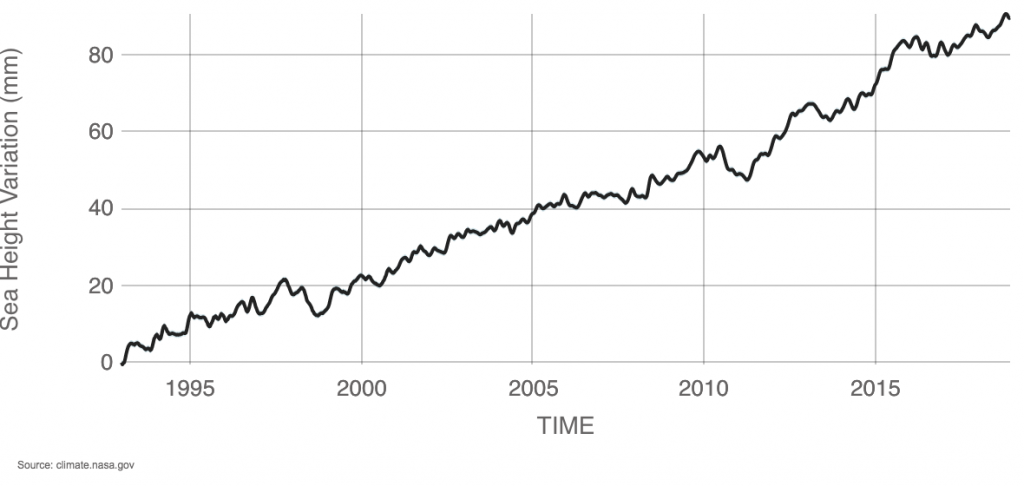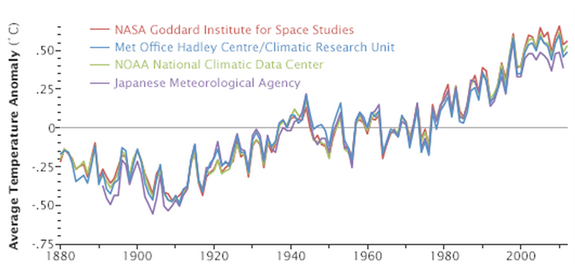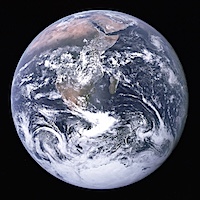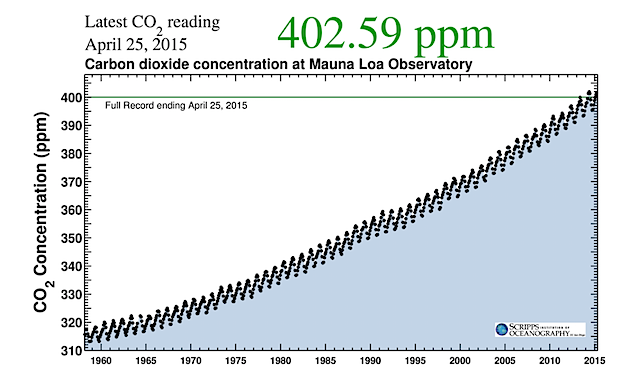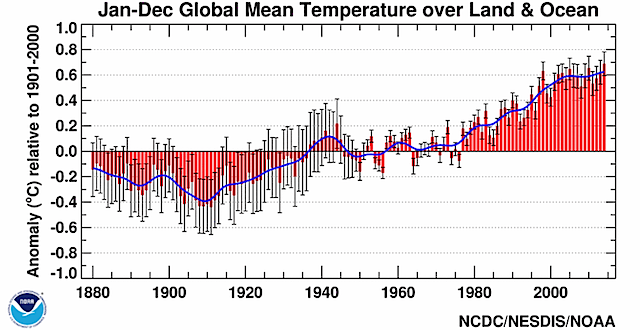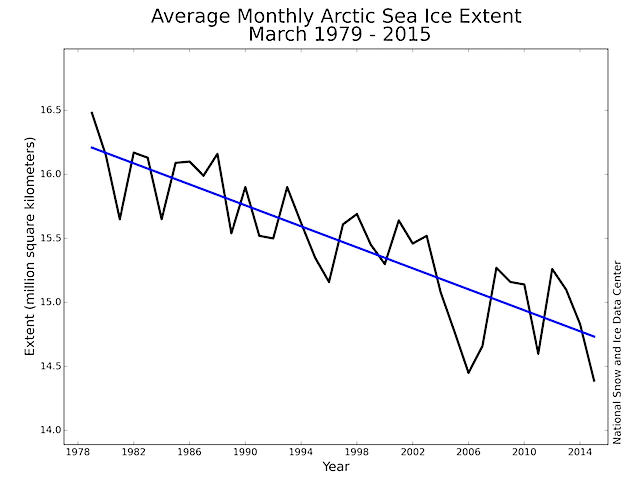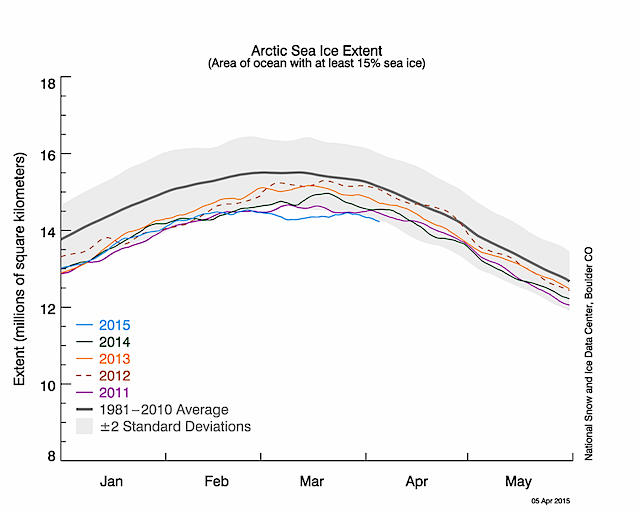A few weeks ago on Facebook I shared a link to the Washington Post Editorial Board’s article, “Want a Green New Deal? Here’s a Better One.” In response a friend of mine who is both a Christian and a skeptic that anthropogenic (i.e., human-caused) climate change is real posted a comment that linked to an Answers Research Journal article from 2010 entitled, “A Proposed Bible-Science Perspective on Global Warming.” (Answers Research Journal is published by Answers in Genesis [AiG], an organization that promotes young-earth creationism.)
This friend was adamant that the AiG article laid out a solid, convincing, biblical, and scientific perspective of why anthropogenic climate change was not real, and thus why any need for policies to mitigate against climate change are completely unnecessary. I promised her that I would read and respond to the article. Pretty quickly it became clear that my response was going to be quite lengthy, so I decided to post this on my blog for the benefit of others, rather than letting it become lost in a soon-forgotten Facebook comment thread.
First off, many, many people write articles that seek to dismiss climate change on the internet, so why am I responding to this one? The main reason is that Answers in Genesis is a fairly prominent organization in conservative Christian circles, and as a theologically conservative Christian, I know many people who trust AiG’s content. This lengthy AiG article has the veneer of being a deep dive into the science of climate change, and clearly has convinced at least some conservative Christians that climate change is a hoax, or at least that it’s nothing to worry about. Second, because this article claims that the Bible refutes anthropogenic climate change, I specifically want to speak against that claim.
Before I begin my response, allow me to lay out my credentials. I am an atmospheric scientist at the National Center for Atmospheric Research (NCAR), where my field of research is primarily in renewable energy forecasting. I have a Ph.D. in Meteorology from Penn State University. I also have a B.A. degree in Physics from Gustavus Adolphus College. While in high school and college, I was a stalwart skeptic of global warming, but as I learned about the physics of the atmosphere in grad school at Penn State, I became convinced that climate change is real and caused primarily by human activity. I even wrote a blog post about my change of mind on climate change back in 2015. I am also a theologically conservative Christian, and an elder in an Acts 29 church plant in Broomfield, CO (Gospel Life Church). I believe the Bible is the inerrant, infallible Word of God and that it is authoritative on all matters on which it teaches. I believe that Jesus Christ is the eternal Son of God and the only means to salvation from our sins. I believe that the miracles described in the Bible really happened, including the bodily resurrection of Jesus a couple days following His execution by crucifixion. I also see no conflict whatsoever between the Bible and the science behind anthropogenic climate change.
One more note about my review below: The AiG article makes a lot of claims and hypotheses surrounding creation/evolution and Noah’s flood. I am not going to comment on or respond to those claims here, except where there is a direct claim made about climate change, as one’s views on creation/evolution really have nothing to do with the veracity of anthropogenic climate change. My purpose here is to evaluate his claims about climate change specifically, as I am an atmospheric scientist, and that is my area of expertise.
And with that preamble out of the way, let’s dive in.
————————
First, the author is a man named Rod Martin. Who is he, and what are his credentials? The AiG bio of Rod Martin is not terribly illuminating. He’s only written four articles for AiG, and only this one was specifically about science. A LinkedIn profile of a man named Rod Martin who was Senior Director of New Media for Answers in Genesis from 2004–2007 suggests that this is likely the same Rod Martin. That public profile (I’m not on LinkedIn, so I don’t know if he has more details hidden from non-contacts on LinkedIn) states that Mr. Martin has a B.A. from Cedarville University (major not given), and a MACE/MABS from Dallas Theological Seminary. It is not apparent that Mr. Martin has any scientific education, credentials, or work experience that would qualify him as a knowledgable source on the science of climate change.
Now into the article itself. I’ll block-quote and italicize excerpts from Rod Martin, and respond below them in regular text. The italicized section headings come from the article, so that you can follow along if you want.
Introduction
“Contrary to what advocates say, a consensus does not exist on global warming.”
This assertion is made without any support. Contrary to Martin’s unsupported assertion, numerous independent studies have shown that the overwhelming majority (>90%) of climate scientists agree that climate change is primarily caused by humans.
Definition of Terms
“Global warming is an assertion that the entire earth’s surface is warming.”
No, it’s an assertion that on average, the earth’s surface is warming. This allows for the possibility that some regions might experience slight cooling while others warm substantially.
The American Meteorological Society (AMS) Glossary entry for climate change gives the following definition: “Any systematic change in the long-term statistics of climate elements (such as temperature, pressure, or winds) sustained over several decades or longer. Climate change may be due to natural external forcings, such as changes in solar emission or slow changes in the earth’s orbital elements; natural internal processes of the climate system; or anthropogenic forcing.”
Primary Issues
“Identifying what global warming advocates want to control helps bring the issue into clearer focus. From this perspective, two issues are of primary concern to global warming advocates: CO2 emissions and the harvesting of forests. They want to control both CO2 emissions and the harvesting of trees.”
CO2 emissions and the health of forests (because of their impact on the carbon cycle) are indeed quite important, but even so, this framing is a rather crass oversimplification of the issues. Also, the political motivations of some have no bearing on the veracity of the science underpinning anthropogenic climate change.
Dominion Mandate
“Using earth resources for the benefit of mankind has never been a moral issue. Ignoring God and disobeying His commands is a moral issue.”
The difference becomes when consuming resources or engaging in certain behaviors causes harm and injustice to other people. The Bible has plenty to say about that.
Noah’s Flood
“God established enough oxygen in the original atmosphere to sustain life throughout the duration of the earth. This highlights the fact that plants are not necessary for generating oxygen.”
This sloppy reasoning confuses a miraculous, supernatural intervention in the physical world with the ordinary natural means by which the physical world operates.
“The argument over burning fossil fuels versus ethanol can be reduced to a question of whether it is best to burn old plants or new plants. Burning old plants (fossil fuels) is much more efficient, and therefore “green.””
What does Martin mean by “efficient” and “green”? I think bringing up ethanol here is a red herring, anyway.
“As a result of burying a major proportion of earth’s plant and animal life, the Flood likely caused far greater changes to atmospheric gases than any current global warming scenario.”
This honestly has no bearing whatsoever on whether anthropogenic climate change is happening, what the causes are, or what the severity of its impacts are expected to be.
“From these verses it appears that until the tribulation occurs no worldwide catastrophe will affect the earth. Global warming is described as a worldwide catastrophe by the radical environmentalists and the media. The tribulation of Revelation certainly contains events that sound like some of the dire predictions associated with global warming. Unlike global warming, the tribulation is initiated directly by God, as judgment on sinful mankind, and is a sudden, not a gradual change. People undergoing the tribulation realize that it is from God, as a result of their sinful behavior, but they intentionally refuse to repent. We should not confuse the claims of global warming with tribulation events.”
Wait, what?? Again, the tribulation has absolutely nothing to do with the question of the veracity of the scientific evidence supporting anthropogenic climate change.
God’s Control of Creation
“Man is not in control of the weather and this present earth is temporary.”
Anthropogenic climate change does not challenge God’s sovereignty whatsoever! There are numerous instances in Scripture of God allowing mankind to experience the disastrous consequences of their actions. Why should climate be any different? Also, several experiments, including a recent field campaign led by NCAR scientists, have in fact shown that we can directly modify the weather via cloud seeding. Also, research has shown that weather is modified by the presence of cities, by changes and boundaries in land use/type, and by other facets of human modification of the environment.
Summary of the Biblical Framework
“Consequently, in view of the massive volume of fossil fuels and carbonate rocks, it is highly probable that today’s atmosphere contains measurably less CO2 than the Creation atmosphere and a correspondingly higher O2 concentration.”
There’s a whole chain of wobbly, hand-waving qualitative reasoning and absolutely no quantitative analysis to reach this conclusion. For what it’s worth, ice core analysis shows that current CO2 concentrations are higher now than at any point in the ice core record (regardless of how many years one thinks that covers).
Science Related to Global Warming
Glaciers
“Fig. 1. Graph of water vapor capacity at saturation (11% relative humidity) versus temperature.”
Saturation occurs at 100% RH, not 11%.
“In other words, glacial melting has been going on for thousands of years and mankind was not the cause. Most of the melting, and subsequent sea level rise, occurred long before the recent increase in atmospheric CO2.”
“Melting glaciers are nothing new. The impressive glacial melt experienced since the peak of the ice age was not due to increased CO2, warming oceans, or anything man had done. Why should we now think that man is responsible for melting glaciers? Clearly, melting glaciers are not proof of global warming.”
This is embarrassingly shoddy logic. The fact that ice melted at the end of the last Ice Age without any anthropogenic causes does not have any bearing on whether anthropogenic CO2 emissions are today leading to warming temperatures and melting glaciers.
“Incidentally, sunken Mediterranean cities also provide historical evidence for rising sea levels. … From this evidence, it appears that over the last 2,000 years the Mediterranean Sea has risen about 1 ft (0.3 m) per 100 years. This average sea level rise is greater than estimates of the rise over the last 100 years (4–10 inches [10–25 cm]). Apparently, sea-level rise is diminishing with time. The level of the Mediterranean Sea rose because melting glaciers added water to the oceans.”
Is this due to rising sea levels or due to land subsidence? I honestly don’t know, but the author simply states it’s due to rising sea levels without citing any sources or addressing the possibility of land subsidence. Also, the author tabs the cause of rising sea levels in the last 2,000 years to glacial melt from the last Ice Age, even though by the author’s own estimation the Ice Age ended well before that time. This doesn’t make sense. And furthermore, while we’ve documented just under 1 foot of global sea level rise in the past century, the rate of observed sea level rise is in fact increasing, and under most climate change scenarios is projected to rise between 1.5–4.5 feet by 2100. That’s a notably faster sea level rise than the author’s unsupported claims about the past 2,000 years!
NASA has some helpful information about sea level rise here, here, and here. As of this writing, global mean sea level has risen about 90 mm +/- 1 mm (3.54 in) since 1993, for an average rate of 3.3 mm/year (0.13 in/year, or 13 in/century). The plot below is from NASA:
Carbon Dioxide
“At what concentration can CO2 be considered a health hazard (the point where it would be an air pollutant)? … The level of CO2 in our atmosphere could increase over 1,300% before reaching the current mine safety limit, and this level has been reduced to only 42% of the prior safe limit. Today’s atmospheric concentration of CO2 is clearly safe for humans.”
When supposedly talking about the science of global warming, it’s… odd… to start out by comparing current atmospheric concentrations of CO2 to mine safety warning concentrations of CO2 to declare that CO2 is safe and therefore not a pollutant. Talk about an exercise in missing the point! The reason that CO2 is classified as a pollutant is not because its rising levels are unsafe for immediate human health, but because rising concentrations of CO2 in the atmosphere are the primary culprit of climate change.
“Without an atmosphere containing GHGs the earth could not support life. Carbon dioxide is one of the atmospheric gases that help moderate earth’s temperature.”
This is true, and nobody disputes this. Without any GHGs in the atmosphere, Earth would be an uninhabitable ball of ice with a global average surface temperature of 0°F (-18°C). Current GHGs instead make the global average surface temperature a comfortable 59°F (15°C). This is about 1.0°C (1.8°F) warmer than the 1880–1900 global mean temperature, with about two-thirds of that warming having occurred since 1975, coincident with steadily increasing atmospheric concentrations of CO2 and methane. We know that GHGs help determine the warmth of a planet, and the author even admits it here. So why is there opposition to the idea that adding more GHGs to the atmosphere would cause the planet to warm on average?
“As a result of increasing levels of CO2, plants can extend both their growing season and the extent of their habitat. Plants need CO2 to exist. If CO2 levels drop to about 220 ppm plants grow very slowly, and if the concentration falls to 150 ppm growth stops entirely. There is far greater danger in lowering the CO2 level, than in increasing the level.”
Again, nobody disputes that CO2 is necessary for plant life, or that increased CO2 is beneficial to plant life. The key question, though, is whether there’s a limit to this effect. In any case, the atmospheric concentration of CO2 has continued upward unabated for decades, indicating that whatever benefit plants might accrue from the increased CO2 is not anywhere near enough to absorb all the extra CO2 that human activities are pumping into the atmosphere year after year. Also, nobody is advocating lowering CO2 levels below pre-industrial levels (which had been stable for thousands of years!), but it seems the author is stealthily implying that this is a serious possibility by warning about it. That’s dishonest scare-mongering.
“The atmosphere is also in contact with the oceans. Gases are continually being exchanged between these two environments. At present the ocean contains at least 60 times more CO2 than the air (Barry and Chorley 1987, p. 5). The ocean is a large buffer for atmospheric gases. As the ocean cools, more CO2 goes into solution, and, as the ocean warms, it gives off CO2. Since the post-flood ocean was much warmer than now, a large volume of atmospheric CO2 has been absorbed by the ocean as it has cooled.”
Yes, CO2 is exchanged between the atmosphere and ocean. However, temperature is not the only factor that controls this exchange. The exchange is more directly controlled by the difference in partial pressure due to CO2, p(CO2). As atmospheric CO2 concentrations increase, the ocean absorbs more CO2 to achieve an equilibrium balance in that partial pressure. If atmospheric CO2 concentrations were to decrease, then the ocean would be a net emitter of CO2 back into the atmosphere, again, to equilibrate this partial pressure of CO2 in the ocean and air. Also, CO2 reacts with water molecules to form carbonic acid and other products. Therefore, as the CO2 content of the oceans has been increasing in recent decades in direct response to the increasing CO2 content of the atmosphere, the pH of the ocean has been decreasing (i.e., the ocean has been becoming more acidic). The gradual acidification of our oceans due to increasing atmospheric CO2 concentrations is a great concern for all the ocean ecosystems that are adapted to what has been a long-term stable acidity.
“Global climate models are too imprecise, and the key input data too limited, to justify initiating major changes in world economics. Climatologists who are pushing the global warming agenda are focusing on a minor GHG component and ignoring the major contributors to the GHG effect, water vapor, and clouds.”
Before ever actually addressing the science behind why CO2 is causally linked to climate change, the author makes this opinion statement, revealing that his primary issue is one of economics, not of science. In an article that is ostensibly about evaluating the science behind global warming, a largely unsupported opinion about economics is both out of place. Also, it seems odd to accuse climatologists of “ignoring the major contributors to the GHG effect” when he himself has so far ignored the impact of CO2 and has not put forth any evidence to support his accusation that climatologists are ignoring things like water vapor and clouds.
“Over the past 100 years atmospheric CO2 has increased 36% (from 280 ppm to 380 ppm). Over this same time interval global temperature is alleged to have increased 1° F (0.6° C). This is an increase of 0.2% (510R [283.3K] to 511R [283.9K] on an absolute scale). Even if all the increase in CO2 is attributed to burning fossil fuels (which it is not) and the increase in temperature is due entirely to CO2 (which is likewise not the case) the correlation between CO2 and temperature is quite weak. At best, advocates are claiming that a 36% increase in CO2 is responsible for a 0.2% increase in temperature.”
When this article was written in 2010, the atmospheric CO2 concentration was indeed approximately 380 ppm. Now in 2019, it has continued increasing to 411 ppm, representing a 46% increase over pre-industrial levels of 280 ppm. Also, current global average temperature is about 1.8°F (1.0°C) above 1880–1900 average temperatures. The fundamental problem with this statement, however, is that the author is trying to argue that he thinks percentage changes in CO2 and temperature ought to be 1:1 in order to be relevant or causative, without presenting any physical reason why he thinks this ought to be so. This reveals a deep ignorance about how the climate system or statistics work. After all, the entire GHG effect that makes Earth habitable only increases Earth’s temperature by 13% over a no-GHG Earth (288 K vs. 255 K). Clearly, large percentage changes in global average surface temperature are not needed to have large impacts on life! [On a more minor note, the “°R” temperature scale is the same as the Fahrenheit scale, but with absolute zero being 0°R (-459.67°F), analogous to how the Kelvin temperature scale is the same as the Celsius scale, but with absolute zero being 0 K (-273.15°C). It’s not a scale I recall ever seeing someone use before, and it took me awhile to figure out that’s what it was.]
“Biblically, CO2 is good. It is needed for life to exist. God created CO2. It is a plant fertilizer, not a pollutant.”
The Bible is silent about CO2, other than it was of course part of the world that God created in the beginning and called “very good.” God also created the laws of chemistry and physics that create smog when sunlight reacts with emissions from vehicles, which is harmful to human health in high concentrations (just look at cities in China!). So while the world that God initially created was indeed “very good,” human-caused changes to concentrations of various molecules in the atmosphere is not therefore also “very good.” This is terrible logic by Martin. Also, saying that CO2 “is a plant fertilizer, not a pollutant,” is both a gross oversimplification, entirely misleading, and not supported by any analysis of why CO2 is now getting labeled as a pollutant.
“If the CO2 wasn’t a problem in the lush pre-Flood earth, it shouldn’t be a problem now. Increasing levels of CO2 are not proof of global warming.”
The author has presented no measurements or data to indicate what he thinks pre-Flood CO2 concentrations were, only hand-waving reasons why they must have been much higher than today. To use this as supposed “proof” that CO2 is not causing global warming today is another example of embarrassingly shoddy logic. The author has not engaged at all with physics of the CO2 molecule, other atmospheric molecules, or radiative transfer, which is to say he has provided absolutely zero evidence that would even cast doubt on the science that supports anthropogenic climate change.
Here’s the core science of anthropogenic climate change. Every molecule preferentially absorbs and re-emits electromagnetic radiation over certain wavelength bands, as determined by their physical and chemical properties. The atmosphere, which is mostly comprised of nitrogen, oxygen, and water vapor, plus other trace gases including carbon dixoide and methane, has a wavelength band that is largely transparent to long-wave infrared radiation emitted by Earth’s surface. This is called the “atmospheric window,” and it is a key feature that allows heat from Earth’s surface to be vented into space, allowing the Earth system to maintain a temperature equilibrium. One of the absorption bands of the CO2 molecule is within this “atmospheric window,” however, so as atmospheric CO2 concentrations increase, less terrestrial radiation escapes to space, as more of it is absorbed by CO2 molecules and then re-emitted in all directions. This causes the equilibrium temperature of the earth to warm. Therefore, all else being equal, we would expect to see warmer surface temperatures as CO2 concentrations increase.
This basic physics and chemistry underpinning anthropogenic climate change is not new, either. Almost 200 years ago, in the 1820s, John Fourier hypothesized about what we now know as the greenhouse effect. In the 1850s John Tyndall carried out several experiments to show that water vapor and carbon dioxide were both strong absorbers of radiation in the atmosphere. In 1856 Eunice Foote presented a paper at the meeting of the American Academy for the Advancement of Science Annual Meeting about the heat-trapping properties of CO2 in the atmosphere. Then in the 1890s Svante Arrhenius made the realization that carbon dioxide, not water vapor, is the long-term controller of Earth’s average temperature, due to the much longer atmospheric lifetime of carbon dioxide (centuries) than water vapor (days). Arrhenius even made a prediction in the late 1890s, long before the advent of computers, that if the atmospheric concentration of CO2 were to double to ~560 ppm through emissions from burning coal and other fossil fuels, that Earth’s average surface temperature would increase by 5–6°C. That prediction is remarkable, and has mostly held up in the 120 years since then. Arrhenius’s prediction is only somewhat higher than the IPCC Fifth Assessment Report’s estimate of equilibrium climate sensitivity to a doubling of CO2, which it summarized, “Climate system properties that determine the response to external forcing have been estimated both from climate models and from analysis of past and recent climate change. The equilibrium climate sensitivity (ECS) is likely in the range 1.5°C to 4.5°C, extremely unlikely less than 1°C, and very unlikely greater than 6°C.” [italics in the original source]
” In summary, we have known that CO2 causes the Earth to warm since the 1800s, and those core hypotheses have been repeatedly confirmed in laboratory studies and by observations since then.
Climate
“We are told that global warming will increase both the frequency and severity of storms. Storms, however, are driven by the temperature difference between a warm equator and cold poles. This temperature difference sends cold fronts down from the north and warm fronts up from the south. Since northern and polar regions are the areas expected to warm the most from global warming, the temperature difference will decrease. Thus warming, if it actually occurred, would result in fewer and less severe storms.”
This paragraph is actually partly correct—but only partly. It is true that the equator–pole temperature gradient is a key feature that leads to the weather that we experience around the globe. A relaxing of the equator–pole temperature gradient by virtue of the poles warming more quickly than the tropics would certainly affect storm tracks. Exactly how is a matter of debate at this time. It is thought that a reduced hemispheric temperature gradient would lead to a slowing of the subtropical and polar jet streams. Some research suggests that this could lead to a wavier jet stream (“Arctic amplification”), which would actually lead to more extreme swings in the weather, including more incursions of the so-called polar vortex into mid-latitudes in winter. And current research is mixed on whether storms like tropical cyclones (hurricanes) would increase in frequency in a warming world, but the research consensus is that a higher percentage of the storms that do form would be stronger, due to warmer air and increased water vapor (due to the increased rates of evaporation that come from warmer air, and the exponentially higher amount of water vapor that warmer air can carry).
Temperature
“We are warned by Al Gore, and on the news, that global surface temperatures have warmed 1° F (0.6° C) over the past 100 years, and that it is now warmer than it has ever been in the history of the earth. As a result of this “huge” temperature increase we must take immediate and extreme action to avert sudden and imminent global disaster. As mentioned in the prior section, most geologists would dispute this claim.”
Most geologists would dispute that anthropogenic climate change is a serious threat that requires immediate action to avert? Really? In the previous section, the only mention of “most geologists” was a reference to most geologists believing that Earth’s global average temperature was significantly warmer at times in the ancient past. That has no bearing on their opinion on current climate change or its severity.
Collection Methodology
“The earth is huge. We simply do not have a sufficient number of collection points (weather stations) to accurately determine earth’s average surface temperature. The problem is complicated by the seas. When approximately 71% of the earth is covered by ocean, but most of the weather stations are on land how can we truly know the temperature of the entire earth?”
There are of course large regions of the globe that have a lower density of weather stations than atmospheric scientists think is ideal. But satellites are a huge aid in increasing coverage of measuring all sorts of parameters, including temperature, all over the globe, including over the oceans. Also, there are numerous floating and fixed buoys and moving ships that report temperature observations over the ocean, so it’s not like scientists are totally guessing at the temperature over the ocean.
“According to these standards, if a weather station is moved five miles (8 km), or 100 ft (30.5 m) in elevation, then it must be designated as a new station. In other words, the N. W. S. believes that an accurate determination of temperature over a large area requires a temperature measuring station at least every five miles (8 km).”
I mean, sure, ideally we’d have a super-dense network of weather stations over the entire planet. But there are various methods for interpolating or estimating the temperature in regions farther away from monitoring stations, and yet these different methods arrive at remarkably similar estimates of global average temperature. The author never mentions the existence or the details of any of these interpolation methods, and thus does not offer any substantive critique.
“In view of a 2° F (1.1° C) temperature error due to siting, what is the significance of a 1° F (0.6° C) temperature change in 100 years? No significance.”
While there are indeed a number of weather stations that have been sited sub-optimally, the warming experienced by a site over a number of years and decades can indeed be significant and meaningful. And the various independent groups estimating global mean temperature certainly have statistical methods to account for this anomalous warming due to known sub-optimal siting. NOAA addresses this very issue here.
“In a typical U. S. city, temperature measurements can easily differ by more than 3° F. (1.7° C) between various parts of town. Consequently, the official temperature reported may have a margin of error of several degrees.”
This is statement is misleading. The official temperature reported does not have a margin of error of several degrees for the station location. That station’s temperature may of course be somewhat different than another location a few miles away.
“Weather stations that once were in the country have been encroached by asphalt and concrete, thus raising the average temperature in the vicinity of the station. Cities become anomalously warm and are not representative of the larger surrounding area.”
Does Martin honestly think that climate scientists are unaware of the urban heat island (UHI) effect, and do not take steps to remove it from temperature datasets? There most certainly are statistical methods used to account for/remove the UHI and other statistical artifacts and quality control issues. The author never even mentions the existence of such corrections, much less describes how these corrections work. Thus, he does not offer any substantive critique.
“As an added point, in order to accurately measure the temperature history of the entire earth it would be necessary to measure temperatures simultaneously. A 24-hour day in New York is not the same time interval as a 24-hour day in Los Angeles or Honolulu. Unless simultaneous time intervals are captured, and averaged, the calculation introduces an additional error.”
Huh?? Perhaps Martin is referring to the existence of time zones, but has he not heard of Universal Time Coordinate (UTC, also known as Zulu time or Greenwich Mean Time), which is the standardized time in which all weather/climate models and observations are kept?
Data Handling
“How can a consistent and accurate global temperature be calculated when the number and location of stations is changing drastically?”
Martin spends exactly zero words investigating how global average temperature records are calculated. If he had carefully looked into it, he may well have answered his own question. Instead, this blind suspicion comes off as a lazy effort to cast doubt in the minds of people who also have little familiarity with statistics. Does he really think statisticians don’t have a solution for handling such changes in data density over time? There are great resources that provide helpful information describing how global average temperature is measured, the reliability of the surface temperature record, and also how surface-based and satellite-based measurements of temperature differ, and which of them is more reliable.
“The average temperature used by climatologists in the 100-year history is merely the average of the high and low readings (maximum and minimum temperature) at each weather station for each day of the year … This method would only be representative if temperature varied uniformly and symmetrically between the high and low temperature reading each day. This is an atypical event. The true average temperature can vary by several degrees from a simple average of the high and low temperatures, especially if partial cloudiness is experienced. If individual stations can experience a daily temperature error of several degrees why should we be alarmed by a 1° F (0.6° C) change in 100 years? The alleged temperature increase is well within the margin of error for each station’s daily reading.”
It is true that for the purposes of climate records, daily mean temperature at a station is calculated by a simple average of the sum of the daily minimum and maximum temperatures. And it is true that this value would be somewhat more accurate if this was calculated from the average of 24 1-hourly temperature measurements on any given day. However, over thousands of days at each of thousands of stations, these small errors in daily mean temperature from simply averaging the daily minimum and maximum temperatures effectively cancel each other out, as the time of day of the passage of fronts or clouds (which can lead to sharp changes in temperature), over the long term, is effectively random. The long-term average “typical day” does in fact have a smooth variation in temperature. Again, these comments show Martin’s unfamiliarity with the subject matter.
“Even if highly accurate daily average temperatures were available from all of the stations, and the number of stations were constant, the global averaging technique would introduce an error which must be considered. How do you calculate an accurate, and representative, global average temperature from the approximately 5,000 stations? Do you calculate a simple mean, are the stations weighted by area, or is an isotherm map developed? If you weight by area how do you determine the area represented by each station? Do you consider topographic boundaries like mountains? What happens to the large areas unrepresented by stations? If you develop an isotherm map you must select from an assortment of methods for using the area of each isotherm to determine an average temperature. The average temperature calculated using these mathematically acceptable techniques can easily vary by more than 1° F (0.6° C) between themselves. The global averaging technique selected introduces a margin of error which must be considered and reported.”
The author seems blissfully unaware that multiple independent groups of climatologists and statisticians have indeed already thought deeply about these issues, proposed somewhat different methods to handle issues such as interpolation into data-sparse regions, and yet have all arrived at very similar results for global average temperature.
Interpretation
“A wide range of surface temperatures exist on the earth simultaneously. At the same time it may be -100° F (-73.3° C) in Antarctica and +130° F (54.4° C) in Death Valley. There will be places on the earth experiencing every temperature between these two extremes. A number of areas on earth will have temperatures between -9° F (-22.2° C) and +9° F (-12.8° C), single digits. According to the rule of significant digits, the end product of a calculation cannot have more significant digits than the component with the least number of significant digits. If we are measuring the earth’s average surface temperature then the end product can have no more than one significant digit, in this case 1° F (0.6° C). We can only know the temperature of the entire earth within 1° F (0.6° C). Therefore, a 1° F (0.6° C) change in 100 years is within the margin of error of the calculation.”
At this point I’m just hitting my head into my desk. This is simply ludicrous. The notion of 1°F being the finest unit of measurement is laughable and wrong. First of all, the precision on most standard thermometers is approximately 0.1°C (~0.2°F), and many thermometers that measure air temperature have even greater precision than that. Second, if we convert single digits on the Fahrenheit scale to the Kelvin scale, the range of -9°F to +9°F is equivalent to 250.37 K to 260.37 K. Martin’s argument of there being just one significant digit because of the existence of single-digit Fahrenheit temperatures (never mind the fact that those temperatures are actually measured at least to the tenth of a degree) looks awfully silly now, doesn’t it?
“As we have seen, there are significant errors in both temperature collection and data handling procedures. These errors can range from a few degrees to as much as 14° F (7.8° C). In view of this, the margin of error for the global temperature history is well over 2° F (1.1° C). If a true margin of error is reported, then a 1° F (0.6° C) temperature rise in 100 years fades into insignificance and the alarm over increasing temperatures evaporates.”
Where does this 14°F figure come from?? Also, it’s clear the author hasn’t taken a class in error analysis or statistics.
“Given that reliable temperature records are a relatively recent event, and climates are constantly changing, we should expect temperature extremes to be regularly broken. Broken temperature records do not prove either global warming or climate change. They merely indicate that we have a small sampling of earth’s temperature history. It is safe to say that even if we had accurate temperature records for the past 100 years it is impossible to know with confidence either the historical range of earth’s surface temperature or if we have exceeded a safe level and are heading towards a disaster.”
When almost two to three times as many warm records are broken annually worldwide than cold records, that actually is a pretty solid indication that the distribution of temperatures is shifting warmer! Again, the author doesn’t understand basic statistics. Here’s a cool video (source) showing how the distribution of surface temperatures has changed since 1850. Notice the shift in the mean and in the tail of the distribution toward warmer temperatures:
Looking at the same data spatially, this is what the temperature records as calculated by Berkeley Earth show (source):
Conclusion
“Reducing CO2 would definitely create problems, but increasing it will not. Burning fossil fuels merely returns CO2 to its place of origin.”
Wow. Considering he has not evaluated any of the projected consequences that will arise from increasing CO2, this statement takes real chutzpah.
“Basic science is consistent with the biblical history and argues strongly against the global warming hypothesis.”
The author did not even address, much less offer any evidence to counter, the basic physics and chemistry that underpins the science of anthropogenic climate change. Basic science is in fact the strongest evidence FOR anthropogenic climate change, and is why we’ve known that increased CO2 leads to warmer temperatures for over 150 years. This has been repeatedly confirmed in laboratories and by observations.
At this point the only two conclusions I can draw about Martin’s article is that Martin is either ignorant and/or being dishonest with the intention to mislead and misinform his readers. Those are the two options.
“There is no viable justification either biblically or scientifically for limiting the generation of CO2 or restricting logging of forests. In view of the great benefit of CO2 it is absolutely unnecessary to consider spending billions of dollars to restrict something that is extremely good for mankind and the earth.”
The Bible calls us to love our neighbor, with a global definition to that (e.g., Luke 10:25–37; Matthew 22:34–40; 1 John 3:11–24). It also calls us to seek justice and take up the cause of the poor and the oppressed. We are called as Christians to pursue truth and not to misrepresent reality. Additionally, the Bible calls us to be good stewards of the world God has given us dominion over. Basic physics and chemistry tells us, and 100+ years of observations confirms, that climate change is happening, that it’s primarily caused by human activities in the last 150 years, and that it poses significant threats to human and ecological flourishing. Increasing atmospheric CO2 will lead to increasingly severe impacts of climate change, the brunt of which will be felt by poorer communities and nations. For instance, sea level rise is expected to displace millions of people, from low-lying island nations like the Maldives to low-lying, densely populated nations like Bangladesh. Destroying other people’s homelands because of our selfish addiction to fossil fuels (and outright deception of Christians about the nature and seriousness of the problem via shoddily reasoned articles like this one) doesn’t seem like a good way to love our neighbor, pursue justice, or steward our environment, does it?
——————
Reading and reviewing this article by Rod Martin made me think of this famous quote from The Literal Meaning of Genesis, Vol. 2 by Augustine of Hippo, one of the early church fathers from northern Africa who lived in the 4th century AD:
“Usually, even a non-Christian knows something about the earth, the heavens, and the other elements of the world, about the motion and orbit of the stars and even their size and relative positions, about the predictable eclipses of the sun and moon, the cycles of the years and the seasons, about the kinds of animals, shrubs, stones, and so forth, and this knowledge he holds to as being certain from reason and experience. Now, it is a disgraceful and dangerous thing for an infidel to hear a Christian, presumably giving the meaning of Holy Scripture, talking nonsense on these topics; and we should take all means to prevent such an embarrassing situation, in which people show up vast ignorance in a Christian and laugh it to scorn. The shame is not so much that an ignorant individual is derided, but that people outside the household of faith think our sacred writers held such opinions, and, to the great loss of those for whose salvation we toil, the writers of our Scripture are criticized and rejected as unlearned men. If they find a Christian mistaken in a field which they themselves know well and hear him maintaining his foolish opinions about our books, how are they going to believe those books in matters concerning the resurrection of the dead, the hope of eternal life, and the kingdom of heaven, when they think their pages are full of falsehoods on facts which they themselves have learnt from experience and the light of reason? Reckless and incompetent expounders of Holy Scripture bring untold trouble and sorrow on their wiser brethren when they are caught in one of their mischievous false opinions and are taken to task by those who are not bound by the authority of our sacred books. For then, to defend their utterly foolish and obviously untrue statements, they will try to call upon Holy Scripture for proof and even recite from memory many passages which they think support their position, although they understand neither what they say nor the things about which they make assertion [quoting 1 Tim 1:7].”
I implore my fellow Christians to not be taken in by the ignorance and deception put forward by Answers in Genesis and Rod Martin in the lengthy article I’ve reviewed here. When it comes to the science of anthropogenic climate change and the Bible, there is no conflict. The Bible does not promise us that we cannot inflict harm on our climate or environment. Physical and chemical properties of the CO2 and methane molecules and the other constituents of the atmosphere dictate that the earth will warm on average in response to increased concentrations of CO2 and methane, and that is exactly what we’ve observed over the past 100+ years. The scientific evidence in favor of anthropogenic climate change is truly overwhelming along multiple fronts, and to deny it is to not deal with reality as it is. Pursue and embrace the truth.
If you want to learn about a topic, learn from subject matter experts (in this case, atmospheric scientists), not from people who have no credentials to indicate they have deep understanding of the subject matter. And in any discipline, including atmospheric science and climatology, there are many practitioners who are also committed Christians. These are the people who should be listened to if you’re concerned about what the Bible has to say about, say, climate change.
I’ll leave you all with this video by Dr. Katharine Hayhoe, a climate scientist from Texas Tech University who is also an evangelical Christian and a pastor’s wife. She produced a video for her “Global Weirding” series of shorts about climate change on YouTube, entitled “The Bible Doesn’t Talk About Climate Change, Right?” I encourage you all to view it. Dr. Hayhoe provides a much more accurate, knowledgable view of the Bible and climate change than did AiG and Rod Martin.
I hope this proves informative and helpful to many. Feel free to respond with questions or comments.

